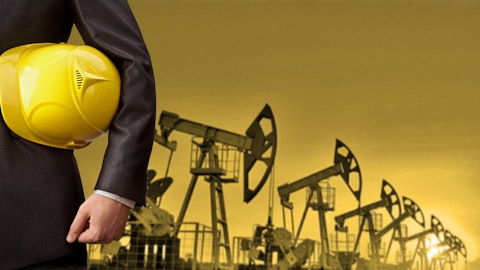While Exxon’s current credit outlook is stable, nonetheless its ability to preserve its impressive 34-year dividend growth streak could eventually end should oil prices remain low for many years; as they did in the 1990’s. That’s because the company’s free cash flow, while positive, is far below its annual dividend cost.
That means that Exxon is currently funding the dividend, including its annual growth, through a combination of non-core asset sales, and debt.

Should oil prices remain below $60 for the next three to five years, the company might have a hard time increasing its quarterly payout even a token amount, such as $0.01 per quarter, per year.
One final risk worth noting is the likely rising of interest rates in the coming few months.
While the US economy continues to grow at a disappointingly slow pace, nonetheless the Federal Reserve maintains that it is strong enough to continue normalizing (i.e. raising) rates. And according to the CME Group, the financial markets are currently putting the probability of an increase in interest rates by December at 65.1%.
While a single 25 basis point increase isn’t that big a blow to Exxon, despite the monstrously capital intensive nature of its business, keep in mind that the Fed currently expects rates to rise by 2.75% over the next four years.
This would make the cost of rolling over its nearly $30 billion debt load much higher, and make securing the dividend, in the event that oil prices remain low for several more years, more costly, should Exxon’s free cash flow fail to rise high enough to cover its payout.
In addition, higher US interest rates will also likely cause the dollar to rise, meaning that oil prices, which are priced in dollars, could come under additional pressure. As would Exxon’s foreign sales and profits, which are collected in foreign currency, and then converted to US dollars for accounting, buyback, and dividend purposes.
Of course, no one has a crystal ball when it comes to forecasting macro conditions. The Fed has been wrong for years regarding the pace and timing of interest rate increases and economic growth. Investors holding Exxon should remain aware that the company remains reasonably safe today but ultimately needs oil prices to rise and favorable credit market conditions.
Dividend Safety Analysis: ExxonMobil
We analyze 25+ years of dividend data and 10+ years of fundamental data to understand the safety and growth prospects of a dividend. Exxon’s dividend and fundamental data charts can all be seen by clicking here.
Our Dividend Safety Score answers the question, “Is the current dividend payment safe?” We look at factors such as current and historical EPS and FCF payout ratios, debt levels, free cash flow generation, industry cyclicality, ROIC trends, and more.
Dividend Safety Scores range from 0 to 100, and conservative dividend investors should stick with firms that score at least 60. Since tracking the data, companies cutting their dividends had an average Dividend Safety Score below 20 at the time of their dividend reduction announcements.

We wrote a detailed analysis reviewing how Dividend Safety Scores are calculated, what their track record has been, and how to use them for your portfolio here (3).
Exxon’s Dividend Safety Score is 52, suggesting that the company’s dividend is reasonably secure and about as safe as the average dividend stock in the market.
This is due to several protective factors. The first is the company’s massively integrated and efficiently run assets, which benefit from such economies of scale that Exxon is able to generate billions of dollars in profits while rivals such as Chevron (CVX) report billions in losses.
In fact, Exxon’s operations are so efficient that over the past 12 months it was able to generate $1.5 billion in free cash flow, or FCF, which is an impressive feat indeed given that it includes $21.4 billion in maintenance, and growth capital expenditures.
And as more of Exxon’s projects come online, resulting in slow but steady production increases over the coming years, its FCF should rise, making the continued maintenance and growth of its dividend a smaller burden on the balance sheet.




